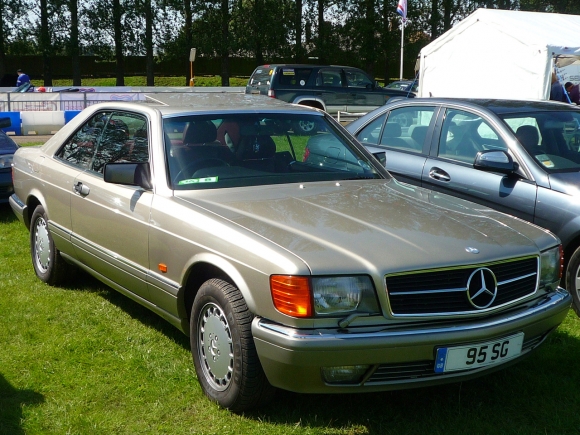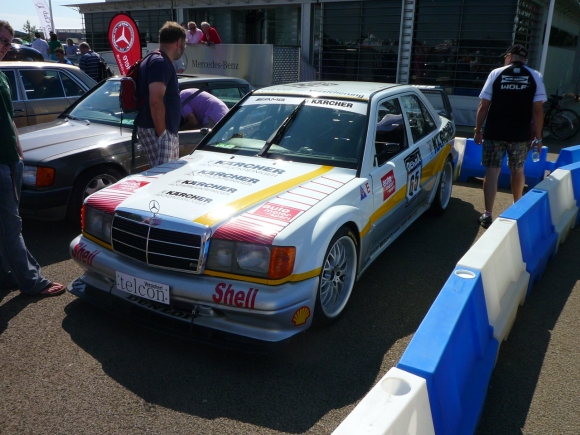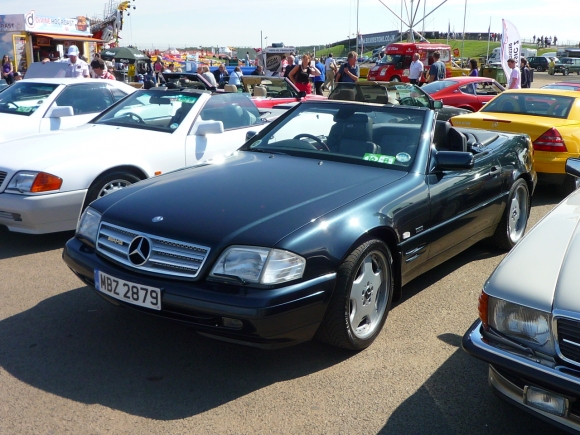We take a look at a few modern classic Mercs that won't break the bank to buy.
In my household we have need for another car. At the moment there is my company-supplied Alfa Romeo Mito which is used for my daily commute to work, and there's the Daytona which is, well, hardly used at all! That leaves a need for a car for my wife to get around in, and also a need for larger capacity than the Mito can manage.
Now, what I should be doing is looking at sensible new or nearly new cars - the Skoda Yeti comes to mind - but instead I've been pouring the internet classifieds lately, looking at older Mercedes. Historically, Mercedes cars have always have a limited appeal to me when new, although some of the more recent offerings like the SLS have begun to change that opinion. However, as they get older Mercedes cars seem to become more desirable.
I suspect that the Mercedes reputation for build quality, combined with styling that fits the brand rather than follows the latest fashion, has something to do with their increased appeal after a few years. The trouble is, in the early 2000s Mercedes lost a lot of that reputation, with many cars suffering from poor build quality and bodywork that seemed to rust rather prematurely. However, if you look back across the previous three decades there are still some classic Mercedes that could be used every day (or at least regularly), and they can be easily be brought for sensible money. Here are my top five presented in chronological order.
1971- 1982 Mercedes SLC (C107)

The SLC is a rather unusual flagship coupe for Mercedes. Based on the R107 SL roadster, Mercedes stretched the SL's wheelbase by 36cm and added a pillarless roof. The resulting coupe is perhaps a little awkward from some angles but still oozes class and is a full four-seater. Initially the car was offered with either a 200bhp 3.5 litre V8 in the 350SLC or a 225bhp 4.5 litre V8 in the 450SLC. Later, a 2.8 litre six (280SLC) was added, and finally the V8 engines were enlarged to 3.8 (380SLC) and 5.0 litres (500SLC). Just before that upgrade the most interesting SLC was introduced, the 450SLC 5.0. This was a car was fitted with lightweight aluminium panels to homologate the car as a rather unlikely rally car. Despite being seemingly totally unsuited to its chosen role, the car was quite successful in endurance events such as the Safari and East Africa rallies.
Today you will probably struggle to find one of these 450SLC 5.0s as Mercedes only made 1636 of them, but for the rest, all are available for less than £10,000, and they are almost always cheaper than their open SL equivalents. Not surprisingly considering the youngest of SLC is thirty years old, rust is an issue, particularly in the front wings and under the windscreen.
The SLC was discontinued in 1982, although the roadster SL continued all the way through to 1989. Mercedes decided that it would return to a saloon-based coupe with the introduction of the W126-based SEC.
1980 1991 Mercedes SEC (W126)

There are plenty of Mercedes W126 saloons still on the road today. If ever there was a car that epitomised Mercedes' reputation for bulletproof build quality, this was it. The Coupe SEC versions, which initially ran alongside but quickly replaced the SLC, were always much rarer but there are still plenty around and a very good example should be available within the £10,000 budget. All versions of the SEC came with V8s, with the most powerful being the 300bhp 5.6 litre 560SEC, making the the big coupe an effortless cruiser, ideal for whisking their well-heeled owners to the Riviera.
Even seemingly well-presented examples of the SEC are currently available for well under £10,000, though it won't be a cheap car to run. Having said that, while they were considered fiendishly complex when new, they're relatively simple cars compared to their modern equivalents and your mechanic won't require a degree in electrical engineering.
The SEC is a great car but it is not in the least bit sporty, although plenty of tuners of the day attempted to add more attitude, with varying degrees of success. For a more enthusiastic driver's Merc of that era you need to look to a smaller and cheaper car.
1983 - 1993 Mercedes 190E 2.3 16V and 2.5 16V

Mercedes needed a car to replace the 450SLC 5.0 in rallying and also in the burgeoning Group A touring car series. Rather than base it on a top-line model, Mercedes developed a version of the basic 190E saloon. Cosmetically the 190E gained a typically Eighties bodykit, but the real fireworks were under the bonnet. Mercedes asked legendary race engine firm Cosworth to develop twin cam 16v heads for the humble 2.3 litre inline four. The result was an impressive 185bhp and a top speed of 143mph. Mercedes also worked to produce an excellent chassis and the only thing that really let the driving experience down was the dog-leg manual gearbox which is very notchy in operation, although you could also have an automatic. In 1987 the engine was enlarged to 2.5 litres to make the 2.5 16V which made 197bhp when fitted with a catalytic converter.
The 2.3 16V had only two real problems. The trouble was, they were the Ford Sierra RS Cosworth and the E30 BMW M3. This pair of legendary cars cleaned up on the track, and the lack of four-wheel drive meant the Merc was an also-ran in the rally world too. Later developments included some very extravagant body kits in the evolution versions, and a looser rule book allowed the 190 to find success in the German DTM series (as shown in the photo above). However, the 2.3 16V's most famous involvement in motorsport came when the car was launched. As something of a PR stunt, Mercedes organised a one-make race for the car with the driving field made up of legendary F1 drivers including Stirling Moss, and then-current drivers Alain Prost, Keke Rosberg and Elio De Angelis. They were all beaten by a young F1 rookie from Brazil: Ayrton Senna.
Today, 190E values lag a long way behind those of the E30 M3 and the winged versions of the Sierra Cosworth, with reasonable examples available for well under £10,000. Again, rust is an issue and that Cosworth engine is bespoke to this model so expect parts prices to be on the high side.
While the 190E 2.3 and 2.5 16v cars had plenty of power for the era, if you want a Mercedes with grunt that would be respectable today you'll need a car that is a little bit bigger.
1989 - 2002 Mercedes SL R129

All the cars I've looked at so far have a certain air of practicality, with four seats and usable boot space for a shopping trip. The R129 SL is realistically only a two-seater, but of all the cars here it is probably the one most likely to be used today as an everyday car.
The R129 took the place of the R107 after its eighteen year run, and it was a much more sporting car than the wafting R107, with a range of straight six cylinder and the new 322bhp four valve per cylinder 5.0 V8 in the 500SL. 1992 saw the introduction of the 600SL with the V12 as used in the 600SEL (see below). While it was more powerful, the big V12 was a heavy unit and general consensus at the time was that the 500SL was nicer to drive and barely any slower. In 1993, the SL badge became a prefix rather than a suffix with the V8 now being known as the SL500. In 1996 a barely noticeable facelift also saw the SL500 upgraded with a five speed automatic transmission and the straight sixes replaced by V6s. Finally, in 1998 a new 32-valve V8 was introduced with a slight reduction in power to 306bhp.
More than worthy of mention for those looking for a more performance-oriented model were the AMG versions. The race and tuning company had developed a close relationship with Mercedes to the point that for the two companies were now jointly developing performance models to be sold through Mercedes dealers (Mercedes would acquire a controlling interest of AMG in 1999). This led to four AMG versions of the R129, firstly the SL60 AMG with a 376bhp 6.0 V8. It was highly regarded when new but only 633 were made, and with less than 50 sold in the UK it's a rare car and sadly it's unlikely that one can be found for less than £10,000 unless it has serious issues. With the revised V8 in 1998 came a new AMG version, the SL55. It boasted 351bhp, although only 65 were made and I've never heard of one in the UK.
Never officially listed, AMG also made performance versions of the V12 with the utterly bonkers SL70 and SL73. Rated at 496bhp for the 7.0 litre and 525bhp for the 7.3 litre engine, these monster V12s would go on to power the Pagani Zonda. With less than 200 made between the two cars and none in right-hand drive, it's safe to assume one of these will cost far more than the £10,000 budget - if you can find one, that is.
As for the regular versions, while the SL500 version is highly regarded the six-cylinder versions shouldn't be overlooked, since some prefer the handling of the smaller-engined cars. I suspect, however, that most people would be attracted by the lure of the rumbling V8 in the 500. Research on the internet forums indicates the '96-'98 model years are the most preferred, with the five-speed auto and the four-valve engine, while the earlier cars can suffer from electrical issues. The optional panoramic hard-top is also a desirable option and worth seeking out. Whichever version you prefer, there are plenty available within the £10,000 budget, and it's this availability that keeps prices low and perhaps results in the R129 being something of a bargain. Older SLs (the Pagoda especially) are appreciating at the moment and it's only a matter of time until the R129 follows suit.
1992 - 1998 Mercedes 600SEL / S600 / CL600 (W140)

It takes a lot of time to develop a new car, which can sometimes mean that the market it's aimed for has changed or even disappeared before the car is even launched. That held true for the W140 Mercedes, the replacement for the W126 S-Class. A bigger and more ostentatious car than its predecessor, it was developed during the economic boom of the late Eighties but launched in the teeth of the Nineties recession. As with all S-Classes it was brimmed full of new technology but the biggest news of all at the top of range was a new flagship 6.0 litre V12 version: the 600 SEL and 600 SEC coupe.
It was no surprise that Mercedes would develop a V12, since arch-rival BMW had been using a V12 unit in their range-topping 7 and 8 Series cars for a few years. The new Mercedes unit produced 402bhp and propelled the car to a limited 155mph, though when delimited over 170mph was possible. Surprisingly, there was little to differentiate the 600 from lesser models other than a V12 badge on the C pillar. After a year of production the car was rebadged in line with Mercedes' new badging policy, with both versions again becoming the S600. Confusingly, the coupe version was later rebadged again to become the CL600 (pictured at top of the page).
The W140 was never exactly a looker, with the coupe in particular looking rather bloated with none of the cool understatement of the previous W126 version. Personally I would prefer one of the later saloon versions which does without the two-tone side cladding of the earlier cars, and maybe mated to a set of AMG rims.
W140s are still a relatively common site on UK roads, but with a list price when new of £140,000+ it's not surprising that the 600 version is rather rarer. Having said that, both saloon and coupe versions can be found for less than £10,000. Obviously running costs are going to be expensive but arguably less than its closest rival when new: the Bentley Turbo R. Previous high-powered versions of the S-Class - the 300 SE 6.3 and 450SEL 6.9 - have attained classic status (and have values far greater than £10,000), and while it's not guaranteed that the 600 versions of the W140 will do the same, they're perhaps worth watching.
Conclusion
Realistically, none of these Mercedes fit the bill for what my wife and I currently require in a car, and as a result I doubt any will find their way into our garage in the near future. However, if you're looking for a cool prestige car for less than the price of a new supermini, any of these cars can make a good case for itself. As to which is best, unless you need the extra passenger space it is hard to look beyond the charms of an R129 Mercedes SL, a car that defines the term modern classic.
Picture credits
W140 Saloon Jagvar via Wikipedia, all other pictures by the author.

_720_540_75_s_c1_c_c_0_0_1@1x.jpg)